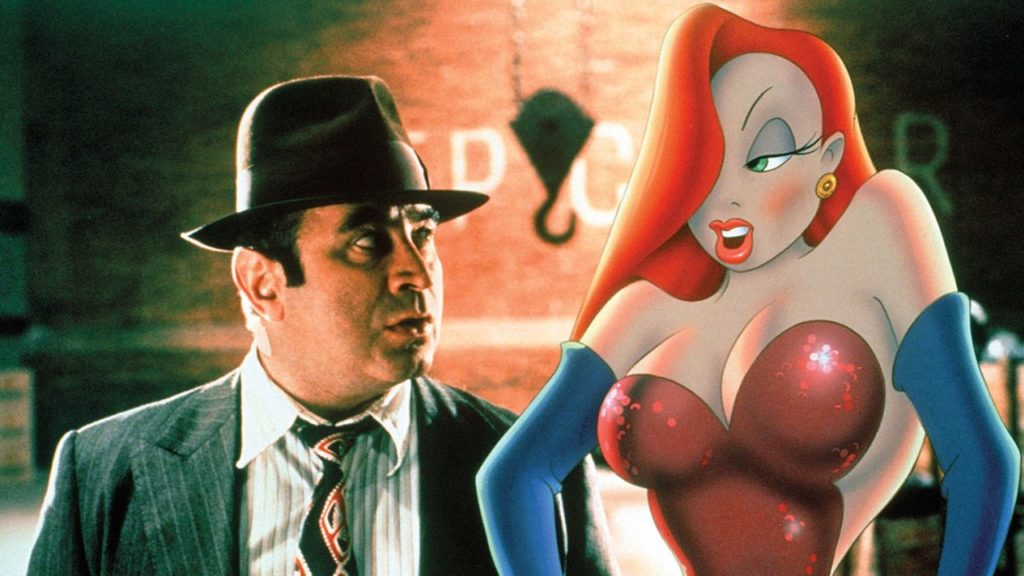[This essay contains spoilers for Who Framed Roger Rabbit]
I’ve been wondering what Who Framed Roger Rabbit asks of its audience, besides the inquiry that gives the film its title and the movie its direction—which, by the way, might not even be a proper inquiry, since the title doesn’t have a question mark (although that seems to be kind of the point).
The movie traffics in perhaps the greatest suspension of disbelief in all of cinema—the assertion of the real-world coexistence of cartoon characters and actual humans. This is such a big hurdle because the addition of something so obviously manmade as animation into a live-action movie makes us remember that what we’re watching is fake, and maybe also reminds us that all film is inherently artificial anyway, even when there aren’t any cartoons. Cinema’s history of brief cartoon cameos, which includes Mickey Mouse talking to the shadow of Leopold Stokowski in Fantasia (1941) and the extended hand-drawn sequences in Mary Poppins (1964) and Bedknobs and Broomsticks (1971) are supposed to take place inside imagination or via magic. But Roger Rabbit, directed by Robert Zemeckis in 1988, suggests that cartoons are real, viable parts of the regular world. And they make the world much more dazzling by being in it! I should mention, before I say anything else, that the special effects in Roger Rabbit are breathtaking; the film’s integration of cartoons and real people is both seamless and spectacular.
Writing out a plot summary of Roger Rabbit (which is based on the novel by Gary K. Wolf), I realize the volume of what the film asks its audience to buy: cartoon characters are real, and cartoon shorts and films are filmed just like regular ones: in Hollywood, with multiple takes, yelling directors, and expensive sets. Toons, as they’re called, are drawn into existence, but wind up living autonomous, three-dimensional lives that have little to do with what they look like (at one point, the femme-fatale Jessica Rabbit explains of her vampish look, “I’m not bad, I’m just drawn that way”). Toons are both totally elastic and are highly durable (dropping safes on top of them won’t do a thing besides send swirly rings of color through their eyes and cause cartoon birds to tweet in circles around their heads). All they generally want to do is be happy and make people laugh. And they live in their own neighborhood in Los Angeles, a Technicolor sing-along paradise called Toontown, which is not governed by the laws of physics and which humans rarely enter.
This is already a mouthful, so it’s lucky that Roger Rabbit is a cartoon (if there were ever a film that could unhinge its own jaw…). There’s more. The film, which is set in 1947, gets going when a human noir-style P.I. named Eddie Valiant (Bob Hoskins) is hired by the president of a cartoon short-film studio called Maroon Cartoons to investigate a possible scandal in the personal life of one of its biggest stars, Roger Rabbit (Charles Fleisher), a goofy giant rabbit in suspenders and a bow-tie. Maroon wants evidence that Roger’s wife Jessica (a sultry cartoon woman with a figure inspired by Rita Hayworth and a voice provided by Kathleen Turner) is cheating on him with the human Marvin Acme, the king of the prop industry and the jolly landlord of Toontown (an elderly Stubby Kaye). Eddie, a traumatized, sardonic alcoholic, is reluctant, because he hates Toons (a Toon killed his brother, who was also his partner in the P.I. business), but he gets the evidence just the same. But then, Marvin Acme is found murdered, and all signs point to Roger (who in his despair, has disappeared—by running through a wall and leaving a cutout of his body behind). Suddenly, Eddie winds up having to clear Roger’s name. Along the way, he bumps into famous cartoon characters, from Disney movies to Mickey Mouse shorts to Looney Toons adventures to a down-and-out Betty Boop, painted in black-and-white and working as a waitress ever since cartoons went to color. Which is, when you think about it, kind of heartbreaking.

Details like the small Betty Boop backstory are what make Roger Rabbit complex—that is, besides, the thousands of other odds-and-ends it juggles. See, Who Framed Roger Rabbit is a hardboiled crime story just as much as it is a colorful cartoon comedy. It takes on two completely different cinematic traditions and is able to keep one foot solidly in each (the film, like its star, is surreally flexible, and not bothered by rules). And it does this with the only possible connection between these two distinct moviemaking canons: the city of Los Angeles, itself. The noir story, which becomes rather Chinatown-esque (as Janet Maslin noted in her original review of the film in The New York Times), and the backlot story are both deeply rooted in a storytelling history that seeks to understand the development of the physical place of Los Angeles in such a way that allowed it to become a hub of cultural elitism. In Roger Rabbit, the murder of Marvin Acme is revealed to be a convenient real-estate grab, by the menacing Judge Doom (a sinister Christopher Lloyd), who has already bought out and destroyed Los Angeles’s cable car network. Judge Doom longs to acquire Toontown so that he can bulldoze it and turn it into a freeway.
Just as Who Framed Roger Rabbit is a clever reimagining of the movie industry that invented cartoon animation, it is also an alternate history of Los Angeles’s transportation systems. And through this, it’s a story about neighborhood re-development, urban planning power-grabs, and gentrification and through this all: class. Despite its hand-drawn aesthetic, anti-gravity antics, silly sound effects, and ceaseless funny business, Who Framed Roger Rabbit is a grim and very serious movie about the disenfranchisement of a group within society labeled as lower-class.
***
The Toons in Roger Rabbit are distinctly second-tier citizens. Their presence is only wanted in the human world because it’s entertaining (no character better emphasizes this than the sexy animated woman Jessica, whose main gig is singing before a crowd of thirsty human men at a cabaret), and when it’s anything else, it’s too much and inconvenient. When they’re not entertaining, they spend their time in their own specific neighborhood, which is owned by a tycoon—and precarious, because of this. It turns out that Marvin Acme has bequeathed Toontown to the residents, and that Judge Doom has been searching for his will, to destroy it, to grant his possession of the neighborhood.
The Toons’ receiving collective ownership of their own land is the film’s happy ending.The Toons’ receiving collective ownership of their own land is the film’s happy ending. Just as much as its residents are fabricated, though, this defeat is a fantasy. In real life, whole neighborhoods in LA were razed for the construction of its enormous highway system, which consists of seven separate freeways and which was constructed, in discrete parts, from 1944-1965. The government seized property from lower-class neighborhoods, particularly in East Los Angeles, displacing many (particularly large swaths of LA’s Mexican-American community), and destroying many historic and locally-significant landmarks, including Hollenbeck Park in the Boyle Heights neighborhood.

Obviously, in real life, neighborhood destruction and urban development policies which target low-class communities are fundamentally racist, as well—because the system does not allow certain ethic groups upward mobility in the first place, most low-class areas are also where non-white communities live. City planning exists to make such spaces more convenient and accessible for classes which are both “upper” and “white,” at the grievous expense of everyone else. It’s not uncommon for noir which tackles large-scale city government policies to reveal how racism factors in; in Chinatown, for example, the oppression of the Los Angeles Chinese-American community is a secret, underlying theme, bubbling up underneath all the interpersonal drama between the wealthy white people who make up the theme’s main cast, to suggest a history of subjugation that runs even deeper than even the abyss of the corruption the main detective is investigating.
It’s worth stating here that though Roger Rabbit‘s noir-coating allows it to call these themes to mind, the film itself does not seem to make an argument about how race is endemic to these policies, which seems good in this case because, in order to do that, it would have to problematically allegorize L.A.’s displaced POC communities as non-human cartoons. The Toons of Roger Rabbit ultimately bear a kind of whiteness—not just the caricature Jessica, who is literally white, but in their origins, having been produced by a white hegemonic imagination and a very white Hollywood, in real life. Notably, George Herriman’s Krazy Kat, a cartoon strip which ran from 1913 to 1944 and reflected much more deeply about race in America (influenced, in part, by Herriman’s own identity as a white-passing black man), is not one of the Toons in Roger Rabbit, despite its having been animated several times. Roger Rabbit for the most part sails over these thornier issues, excoriating the social destruction inherent to capitalism without going into too much detail about its specific victims—representing its cartoons as a kind of alternate anthropomorphized species (creatures living in their own particular ecosystem, one which is threatened by human greed) in a world where race doesn’t really exist.
***
The big message at the end of Roger Rabbit is about the importance of laughter and fun and friendship and community. Eddie Valiant learns how to laugh again, but also how to love. That our protagonist learns both of these things at the same time is a very satisfying ending for Roger Rabbit, which relies on our love of cartoons just as much as our inclination to laugh because of them. It’s essential, then, to this happy ending that the Toons will cooperatively own their own neighborhood and that the destroyer of the cable car system has been defeated; they will be protected from eviction and disenfranchisement, and the preservation of their neighborhood will also help preserve mass transit in Los Angeles, and therefore prevent Los Angeles from simply serving the elite. Los Angeles will now serve all its citizens.
See, Roger Rabbit is decidedly non-noir in its particular kind of hopefulness. But it doesn’t have hope in humanity—it has hope in movies.See, Roger Rabbit is decidedly non-noir in its particular kind of hopefulness. But it doesn’t have hope in humanity—it has hope in movies. Rather like the recent Quentin Tarantino films that rewrite history (Inglorious Basterds and Once Upon a Time… in Hollywood), Roger Rabbit believes that, just as movies can show us the impossible physical interaction between real people and cartoon characters, they can also give us the happy endings we don’t get in real life. Movies—specifically cartoons, the most wonderful kinds of movies—are what saves Los Angeles neighborhoods and public transportation and basically the soul of the city.
In Roger Rabbit, only by working together, living together, and sharing with one another, do we find true joy. This is the take-away for audiences to bring back to real life; at the end of the day, the movie knows that ensuring the well-being of citizens is very, very serious business. But Roger Rabbit’s biggest message is that, just like how cartoons aren’t ruled by Newtonian laws, movies aren’t really governed by rules, either. And movies will always make up the hope and happiness we don’t get to have in real life.

















